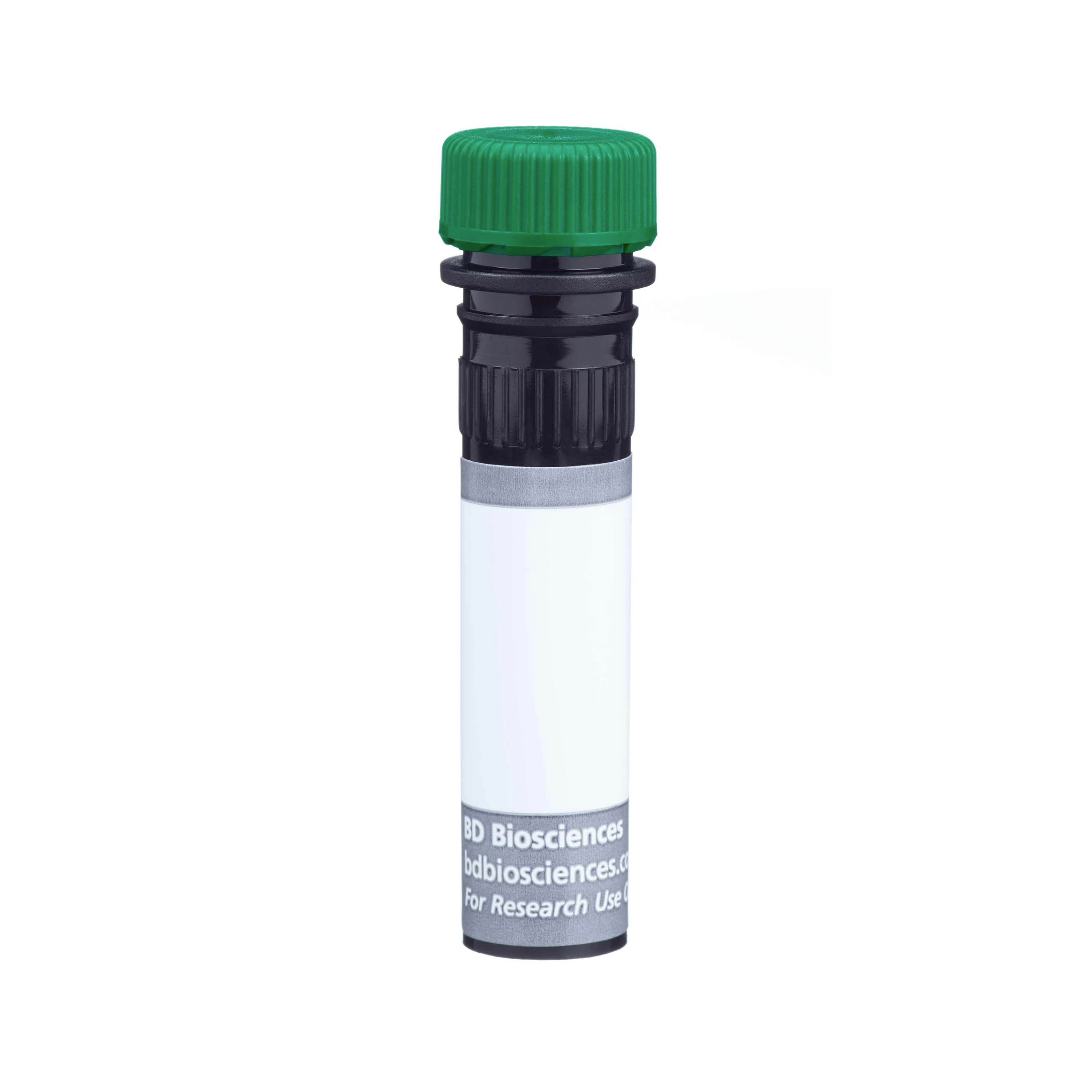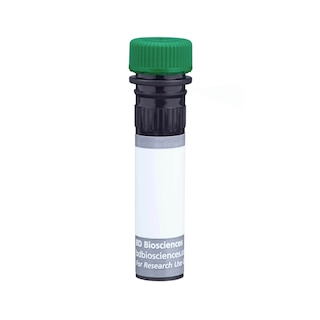-
Training
- Flow Cytometry Basic Training
-
Product-Based Training
- BD Accuri™ C6 Plus Cell Analyzer
- BD FACSAria™ Cell Sorter Cell Sorter
- BD FACSCanto™ Cell Analyzer
- BD FACSDiscover™ A8 Cell Analyzer
- BD FACSDiscover™ S8 Cell Sorter
- BD FACSDuet™ Sample Preparation System
- BD FACSLyric™ Cell Analyzer
- BD FACSMelody™ Cell Sorter
- BD FACSymphony™ Cell Analyzer
- BD LSRFortessa™ Cell Analyzer
- Advanced Training
Old Browser
This page has been recently translated and is available in French now.
Looks like you're visiting us from {countryName}.
Would you like to stay on the current location site or be switched to your location?
BD Horizon™ BUV563 Mouse Anti-Human ICOS (CD278)
Clone DX29 (RUO)

Flow cytometric analysis of ICOS (CD278) expression on stimulated human peripheral blood lymphocytes. Phytohemagglutinin (PHA)-stimulated (3 days) peripheral blood mononuclear cells were stained with either BD Horizon™ BUV563 Mouse IgG1 κ Isotype Control (Cat. No. 612920; dashed line histogram) or BD Horizon™ BUV563 Mouse Anti-Human ICOS (CD278) antibody (Cat. No. 568215; solid line histogram) at 0.25 µg/test. BD Via-Probe™ Cell Viability 7-AAD Solution (Cat. No. 555815/555816) was added to cells right before analysis. The fluorescence histogram showing ICOS (CD278) expression (or Ig Isotype control staining) was derived from gated events with the forward and side light-scatter characteristics of viable (7-AAD-negative) stimulated lymphocytes. Flow cytometry and data analysis were performed using a BD LSRFortessa™ X-20 Cell Analyzer System and FlowJo™ software. Data shown on this Technical Data Sheet are not lot specific.


Flow cytometric analysis of ICOS (CD278) expression on stimulated human peripheral blood lymphocytes. Phytohemagglutinin (PHA)-stimulated (3 days) peripheral blood mononuclear cells were stained with either BD Horizon™ BUV563 Mouse IgG1 κ Isotype Control (Cat. No. 612920; dashed line histogram) or BD Horizon™ BUV563 Mouse Anti-Human ICOS (CD278) antibody (Cat. No. 568215; solid line histogram) at 0.25 µg/test. BD Via-Probe™ Cell Viability 7-AAD Solution (Cat. No. 555815/555816) was added to cells right before analysis. The fluorescence histogram showing ICOS (CD278) expression (or Ig Isotype control staining) was derived from gated events with the forward and side light-scatter characteristics of viable (7-AAD-negative) stimulated lymphocytes. Flow cytometry and data analysis were performed using a BD LSRFortessa™ X-20 Cell Analyzer System and FlowJo™ software. Data shown on this Technical Data Sheet are not lot specific.

Flow cytometric analysis of ICOS (CD278) expression on stimulated human peripheral blood lymphocytes. Phytohemagglutinin (PHA)-stimulated (3 days) peripheral blood mononuclear cells were stained with either BD Horizon™ BUV563 Mouse IgG1 κ Isotype Control (Cat. No. 612920; dashed line histogram) or BD Horizon™ BUV563 Mouse Anti-Human ICOS (CD278) antibody (Cat. No. 568215; solid line histogram) at 0.25 µg/test. BD Via-Probe™ Cell Viability 7-AAD Solution (Cat. No. 555815/555816) was added to cells right before analysis. The fluorescence histogram showing ICOS (CD278) expression (or Ig Isotype control staining) was derived from gated events with the forward and side light-scatter characteristics of viable (7-AAD-negative) stimulated lymphocytes. Flow cytometry and data analysis were performed using a BD LSRFortessa™ X-20 Cell Analyzer System and FlowJo™ software. Data shown on this Technical Data Sheet are not lot specific.



Regulatory Status Legend
Any use of products other than the permitted use without the express written authorization of Becton, Dickinson and Company is strictly prohibited.
Preparation And Storage
Recommended Assay Procedures
BD® CompBeads can be used as surrogates to assess fluorescence spillover (Compensation). When fluorochrome conjugated antibodies are bound to CompBeads, they have spectral properties very similar to cells. However, for some fluorochromes there can be small differences in spectral emissions compared to cells, resulting in spillover values that differ when compared to biological controls. It is strongly recommended that when using a reagent for the first time, users compare the spillover on cells and CompBead to ensure that BD® CompBeads are appropriate for your specific cellular application.
For optimal and reproducible results, BD Horizon Brilliant Stain Buffer should be used anytime BD Horizon Brilliant dyes are used in a multicolor flow cytometry panel. Fluorescent dye interactions may cause staining artifacts which may affect data interpretation. The BD Horizon Brilliant Stain Buffer was designed to minimize these interactions. When BD Horizon Brilliant Stain Buffer is used in in the multicolor panel, it should also be used in the corresponding compensation controls for all dyes to achieve the most accurate compensation. For the most accurate compensation, compensation controls created with either cells or beads should be exposed to BD Horizon Brilliant Stain Buffer for the same length of time as the corresponding multicolor panel. More information can be found in the Technical Data Sheet of the BD Horizon Brilliant Stain Buffer (Cat. No. 563794/566349) or the BD Horizon Brilliant Stain Buffer Plus (Cat. No. 566385).
Note: When using high concentrations of antibody, background binding of this dye to erythroid cell subsets (mature erythrocytes and precursors) has been observed. For researchers studying these cell populations, or in cases where light scatter gating does not adequately exclude these cells from the analysis, this background may be an important factor to consider when selecting reagents for panel(s).
Product Notices
- Please refer to www.bdbiosciences.com/us/s/resources for technical protocols.
- Caution: Sodium azide yields highly toxic hydrazoic acid under acidic conditions. Dilute azide compounds in running water before discarding to avoid accumulation of potentially explosive deposits in plumbing.
- Since applications vary, each investigator should titrate the reagent to obtain optimal results.
- For fluorochrome spectra and suitable instrument settings, please refer to our Multicolor Flow Cytometry web page at www.bdbiosciences.com/colors.
- An isotype control should be used at the same concentration as the antibody of interest.
- CF™ is a trademark of Biotium, Inc.
- BD Horizon Brilliant Stain Buffer is covered by one or more of the following US patents: 8,110,673; 8,158,444; 8,575,303; 8,354,239.
- BD Horizon Brilliant Ultraviolet 563 is covered by one or more of the following US patents: 8,110,673; 8,158,444; 8,227,187; 8,575,303; 8,354,239.
- Please refer to http://regdocs.bd.com to access safety data sheets (SDS).
- Human donor specific background has been observed in relation to the presence of anti-polyethylene glycol (PEG) antibodies, developed as a result of certain vaccines containing PEG, including some COVID-19 vaccines. We recommend use of BD Horizon Brilliant™ Stain Buffer in your experiments to help mitigate potential background. For more information visit https://www.bdbiosciences.com/en-us/support/product-notices.
Companion Products






The DX29 monoclonal antibody specifically binds to human CD278, which is also known as Inducible Costimulator (ICOS) or Inducible T-cell Costimulator. ICOS is a homodimeric type I transmembrane glycoprotein with an approximate molecular weight of 50-60 kDa. It is a member of the CD28 family and is highly expressed on activated T cells. CD278 is the receptor for ICOS-ligand (also known as, CD275, B7-H2, B7RP-1, or LICOS). Like CD28, ICOS can provide a costimulatory signal for T cell activation, proliferation and cytokine production. It is not expressed on resting or activated B cells, monocytes, NK cells, granulocytes, dendritic cells or platelets. Unlike the constitutively expressed CD28, ICOS is de novo expressed upon cellular activation. Reports describe similarities between CD28 and ICOS in T cell activation, such as the costimulation of cytokine production. However, it has been suggested that ICOS may play a greater role in IL-10 production. In the presence of IL-10, purified recombinant human ICOS protein significantly increased in vitro B cell growth stimulated by pokeweed mitogen (PWM) and enhanced production of IgG.

Development References (7)
-
Ahlmanner F, Sundström P, Akeus P, et al. CD39+ regulatory T cells accumulate in colon adenocarcinomas and display markers of increased suppressive function.. Oncotarget. 2018; 9(97):36993-37007. (Clone-specific: Flow cytometry). View Reference
-
Aicher A, Hayden-Ledbetter M, Brady WA, et al. Characterization of human inducible costimulator ligand expression and function. J Immunol. 2000; 164(9):4689-4696. (Biology). View Reference
-
Dong C, Nurieva RI. Regulation of immune and autoimmune responses by ICOS. J Autoimmun. 2003; 21(3):255-260. (Biology). View Reference
-
Fos C, Salles A, Lang V, et al. ICOS ligation recruits the p50alpha PI3K regulatory subunit to the immunological synapse. J Immunol. 2008; 181(3):1969-1977. (Clone-specific: Flow cytometry). View Reference
-
Kallinich T, Beier KC, Gelfand EW, Kroczek RA, Hamelmann E. Co-stimulatory molecules as potential targets for therapeutic intervention in allergic airway disease. Clin Exp Allergy. 2005; 35(12):1521-1534. (Biology). View Reference
-
Sayin I, Radtke AJ, Vella LA, et al. Spatial distribution and function of T follicular regulatory cells in human lymph nodes.. J Exp Med. 2018; 215(6):1531-1542. (Clone-specific: Flow cytometry). View Reference
-
Witsch EJ, Peiser M, Hutloff A, et al. ICOS and CD28 reversely regulate IL-10 on re-activation of human effector T cells with mature dendritic cells. Eur J Immunol. 2002; 32(9):2680-2686. (Biology). View Reference
Please refer to Support Documents for Quality Certificates
Global - Refer to manufacturer's instructions for use and related User Manuals and Technical data sheets before using this products as described
Comparisons, where applicable, are made against older BD Technology, manual methods or are general performance claims. Comparisons are not made against non-BD technologies, unless otherwise noted.
For Research Use Only. Not for use in diagnostic or therapeutic procedures.